Report: Vehicle Congestion Control Based on IoT System
VerifiedAdded on 2020/03/04
|8
|1430
|254
Report
AI Summary
This report explores a vehicle congestion control system based on the Internet of Things (IoT). It details the system's architecture, which includes sensors (IR sensors, photo transistors), microcontrollers, Bluetooth controllers, and an Android application for real-time traffic data visualization. The system monitors traffic density, weather conditions, and pollution levels, providing drivers with alternative routes to avoid congestion. The report discusses the advantages, such as advanced congestion detection and pollution status, and disadvantages, including the reliance on a high-speed internet connection and the potential for system failure. The report also covers the working process of the system with its hardware and software modules, the use of Naive Bayes and KNN algorithms for data mining, and concludes by emphasizing the importance of ITS in traffic management.
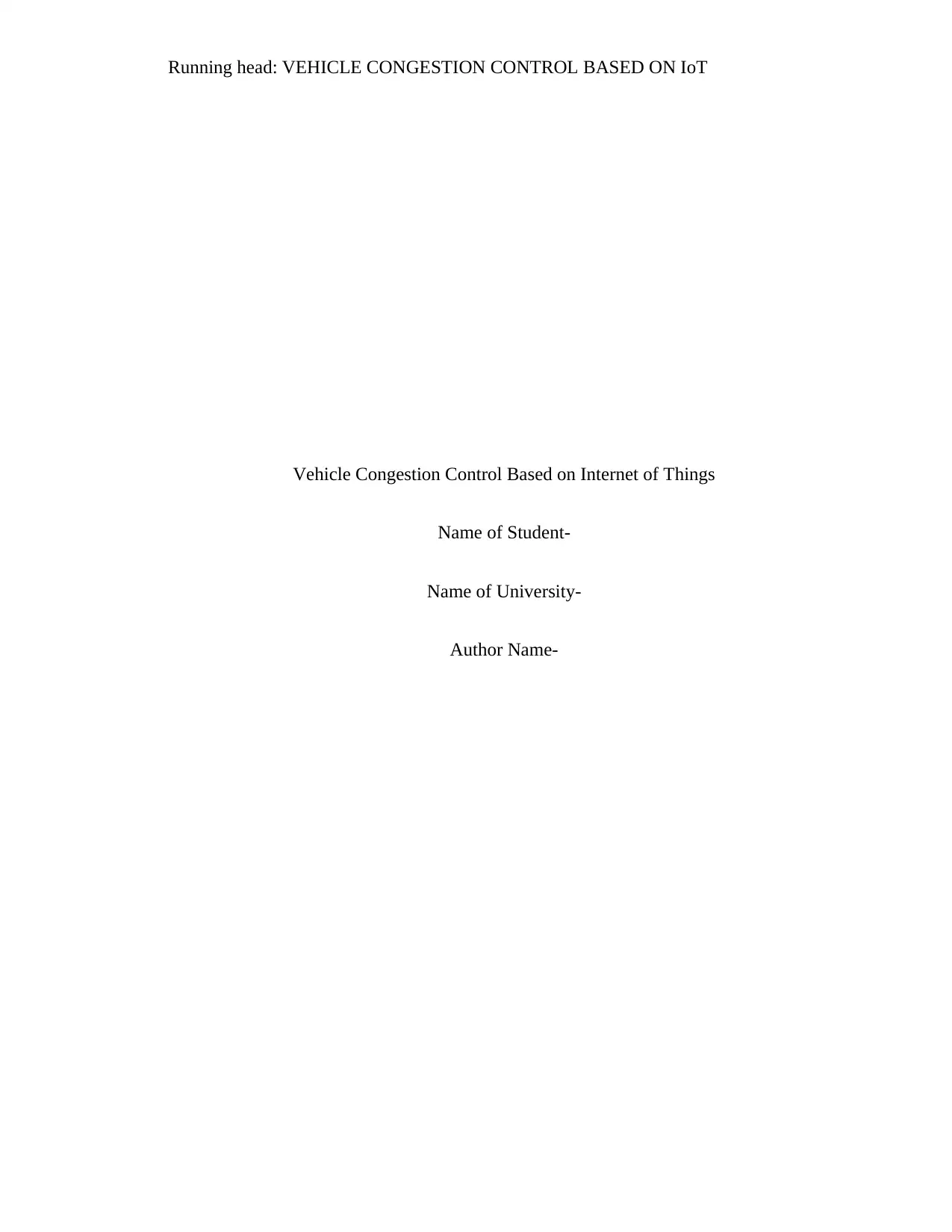
Running head: VEHICLE CONGESTION CONTROL BASED ON IoT
Vehicle Congestion Control Based on Internet of Things
Name of Student-
Name of University-
Author Name-
Vehicle Congestion Control Based on Internet of Things
Name of Student-
Name of University-
Author Name-
Paraphrase This Document
Need a fresh take? Get an instant paraphrase of this document with our AI Paraphraser
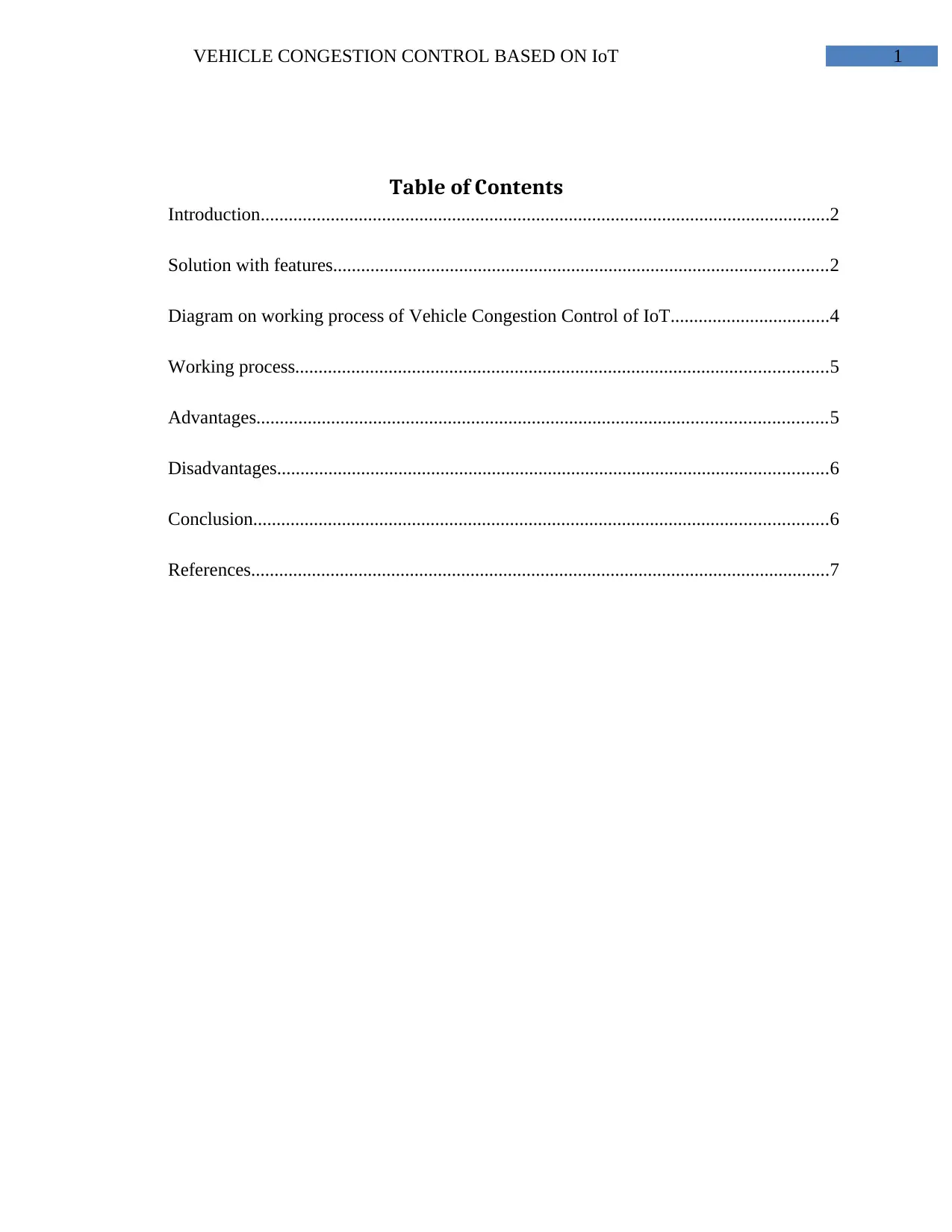
1VEHICLE CONGESTION CONTROL BASED ON IoT
Table of Contents
Introduction..........................................................................................................................2
Solution with features..........................................................................................................2
Diagram on working process of Vehicle Congestion Control of IoT..................................4
Working process..................................................................................................................5
Advantages..........................................................................................................................5
Disadvantages......................................................................................................................6
Conclusion...........................................................................................................................6
References............................................................................................................................7
Table of Contents
Introduction..........................................................................................................................2
Solution with features..........................................................................................................2
Diagram on working process of Vehicle Congestion Control of IoT..................................4
Working process..................................................................................................................5
Advantages..........................................................................................................................5
Disadvantages......................................................................................................................6
Conclusion...........................................................................................................................6
References............................................................................................................................7
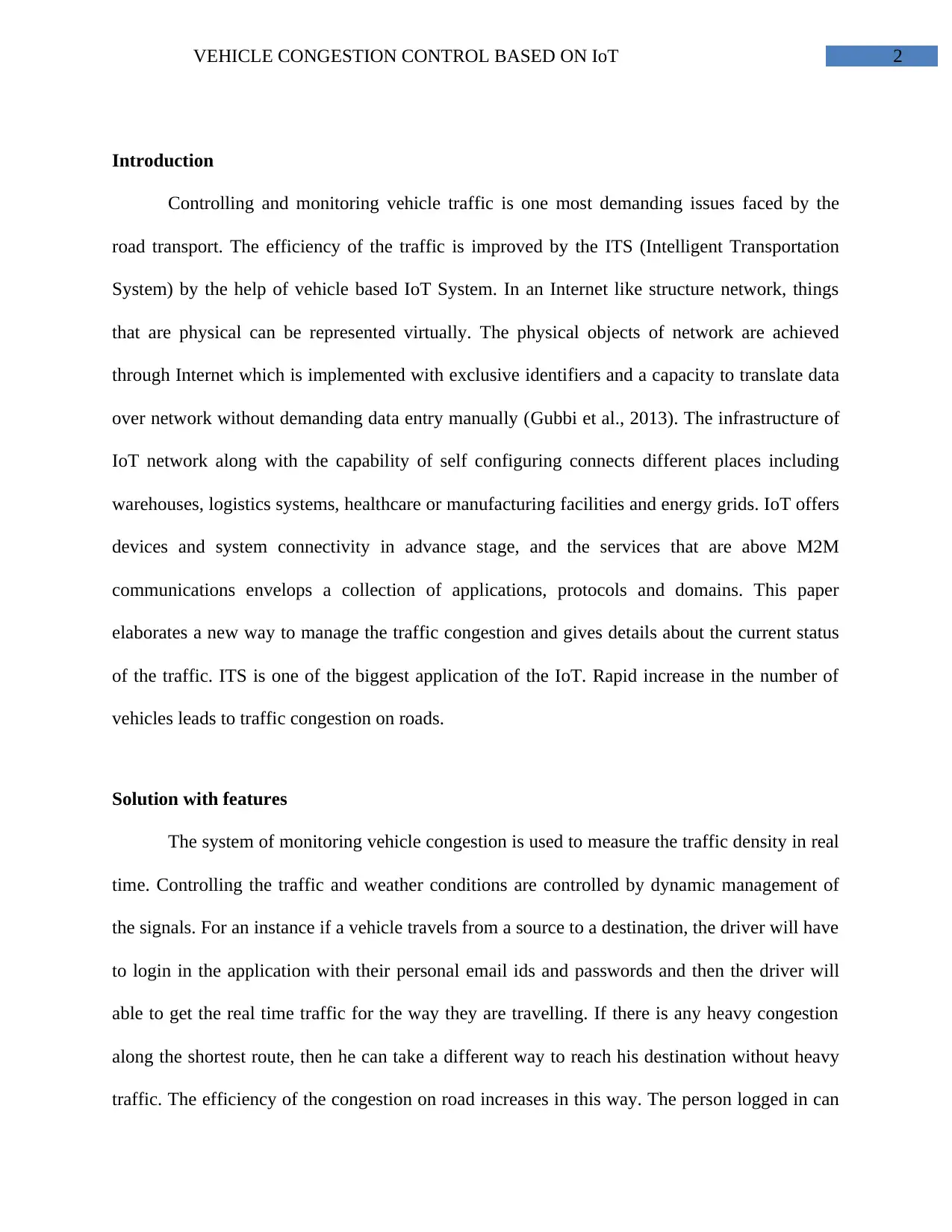
2VEHICLE CONGESTION CONTROL BASED ON IoT
Introduction
Controlling and monitoring vehicle traffic is one most demanding issues faced by the
road transport. The efficiency of the traffic is improved by the ITS (Intelligent Transportation
System) by the help of vehicle based IoT System. In an Internet like structure network, things
that are physical can be represented virtually. The physical objects of network are achieved
through Internet which is implemented with exclusive identifiers and a capacity to translate data
over network without demanding data entry manually (Gubbi et al., 2013). The infrastructure of
IoT network along with the capability of self configuring connects different places including
warehouses, logistics systems, healthcare or manufacturing facilities and energy grids. IoT offers
devices and system connectivity in advance stage, and the services that are above M2M
communications envelops a collection of applications, protocols and domains. This paper
elaborates a new way to manage the traffic congestion and gives details about the current status
of the traffic. ITS is one of the biggest application of the IoT. Rapid increase in the number of
vehicles leads to traffic congestion on roads.
Solution with features
The system of monitoring vehicle congestion is used to measure the traffic density in real
time. Controlling the traffic and weather conditions are controlled by dynamic management of
the signals. For an instance if a vehicle travels from a source to a destination, the driver will have
to login in the application with their personal email ids and passwords and then the driver will
able to get the real time traffic for the way they are travelling. If there is any heavy congestion
along the shortest route, then he can take a different way to reach his destination without heavy
traffic. The efficiency of the congestion on road increases in this way. The person logged in can
Introduction
Controlling and monitoring vehicle traffic is one most demanding issues faced by the
road transport. The efficiency of the traffic is improved by the ITS (Intelligent Transportation
System) by the help of vehicle based IoT System. In an Internet like structure network, things
that are physical can be represented virtually. The physical objects of network are achieved
through Internet which is implemented with exclusive identifiers and a capacity to translate data
over network without demanding data entry manually (Gubbi et al., 2013). The infrastructure of
IoT network along with the capability of self configuring connects different places including
warehouses, logistics systems, healthcare or manufacturing facilities and energy grids. IoT offers
devices and system connectivity in advance stage, and the services that are above M2M
communications envelops a collection of applications, protocols and domains. This paper
elaborates a new way to manage the traffic congestion and gives details about the current status
of the traffic. ITS is one of the biggest application of the IoT. Rapid increase in the number of
vehicles leads to traffic congestion on roads.
Solution with features
The system of monitoring vehicle congestion is used to measure the traffic density in real
time. Controlling the traffic and weather conditions are controlled by dynamic management of
the signals. For an instance if a vehicle travels from a source to a destination, the driver will have
to login in the application with their personal email ids and passwords and then the driver will
able to get the real time traffic for the way they are travelling. If there is any heavy congestion
along the shortest route, then he can take a different way to reach his destination without heavy
traffic. The efficiency of the congestion on road increases in this way. The person logged in can
⊘ This is a preview!⊘
Do you want full access?
Subscribe today to unlock all pages.

Trusted by 1+ million students worldwide
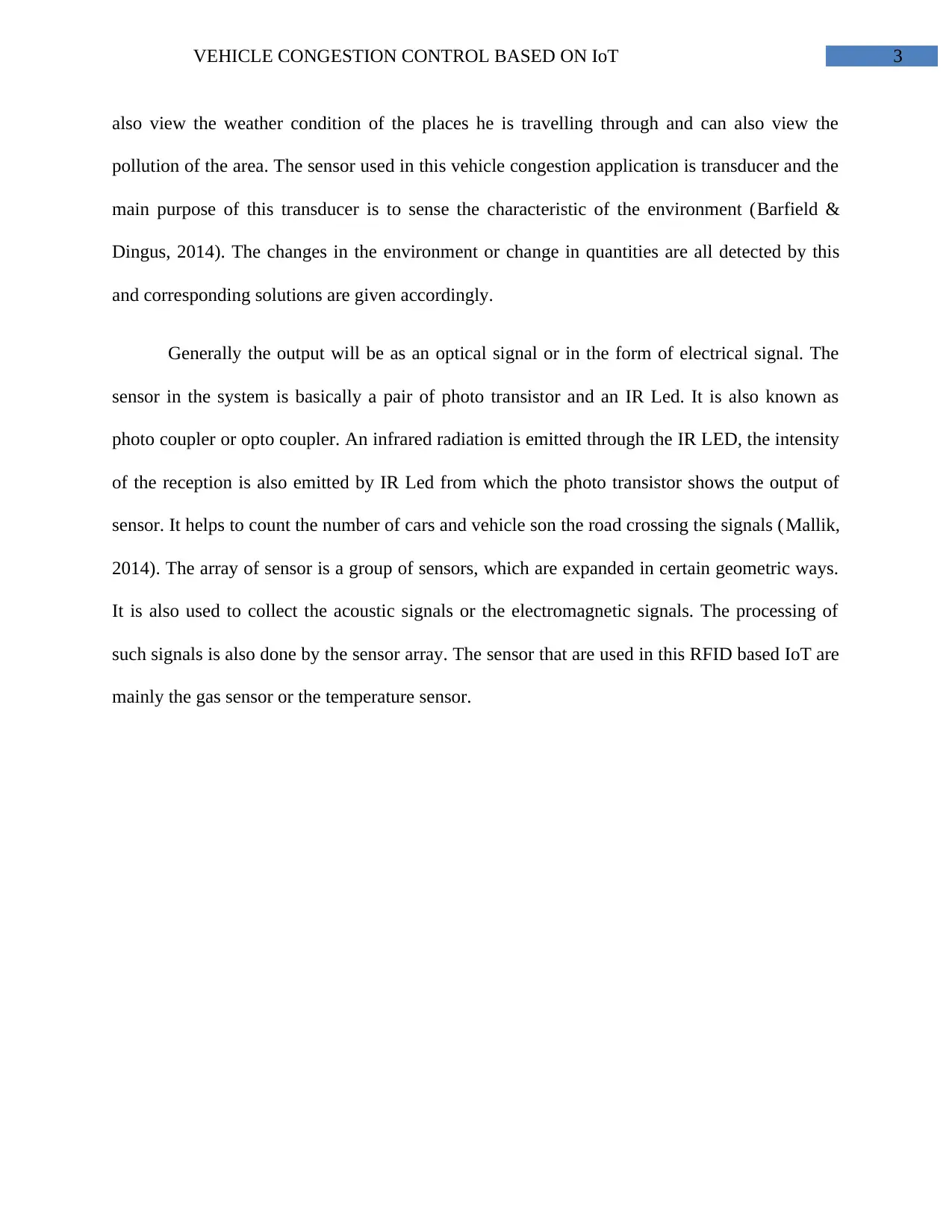
3VEHICLE CONGESTION CONTROL BASED ON IoT
also view the weather condition of the places he is travelling through and can also view the
pollution of the area. The sensor used in this vehicle congestion application is transducer and the
main purpose of this transducer is to sense the characteristic of the environment (Barfield &
Dingus, 2014). The changes in the environment or change in quantities are all detected by this
and corresponding solutions are given accordingly.
Generally the output will be as an optical signal or in the form of electrical signal. The
sensor in the system is basically a pair of photo transistor and an IR Led. It is also known as
photo coupler or opto coupler. An infrared radiation is emitted through the IR LED, the intensity
of the reception is also emitted by IR Led from which the photo transistor shows the output of
sensor. It helps to count the number of cars and vehicle son the road crossing the signals (Mallik,
2014). The array of sensor is a group of sensors, which are expanded in certain geometric ways.
It is also used to collect the acoustic signals or the electromagnetic signals. The processing of
such signals is also done by the sensor array. The sensor that are used in this RFID based IoT are
mainly the gas sensor or the temperature sensor.
also view the weather condition of the places he is travelling through and can also view the
pollution of the area. The sensor used in this vehicle congestion application is transducer and the
main purpose of this transducer is to sense the characteristic of the environment (Barfield &
Dingus, 2014). The changes in the environment or change in quantities are all detected by this
and corresponding solutions are given accordingly.
Generally the output will be as an optical signal or in the form of electrical signal. The
sensor in the system is basically a pair of photo transistor and an IR Led. It is also known as
photo coupler or opto coupler. An infrared radiation is emitted through the IR LED, the intensity
of the reception is also emitted by IR Led from which the photo transistor shows the output of
sensor. It helps to count the number of cars and vehicle son the road crossing the signals (Mallik,
2014). The array of sensor is a group of sensors, which are expanded in certain geometric ways.
It is also used to collect the acoustic signals or the electromagnetic signals. The processing of
such signals is also done by the sensor array. The sensor that are used in this RFID based IoT are
mainly the gas sensor or the temperature sensor.
Paraphrase This Document
Need a fresh take? Get an instant paraphrase of this document with our AI Paraphraser
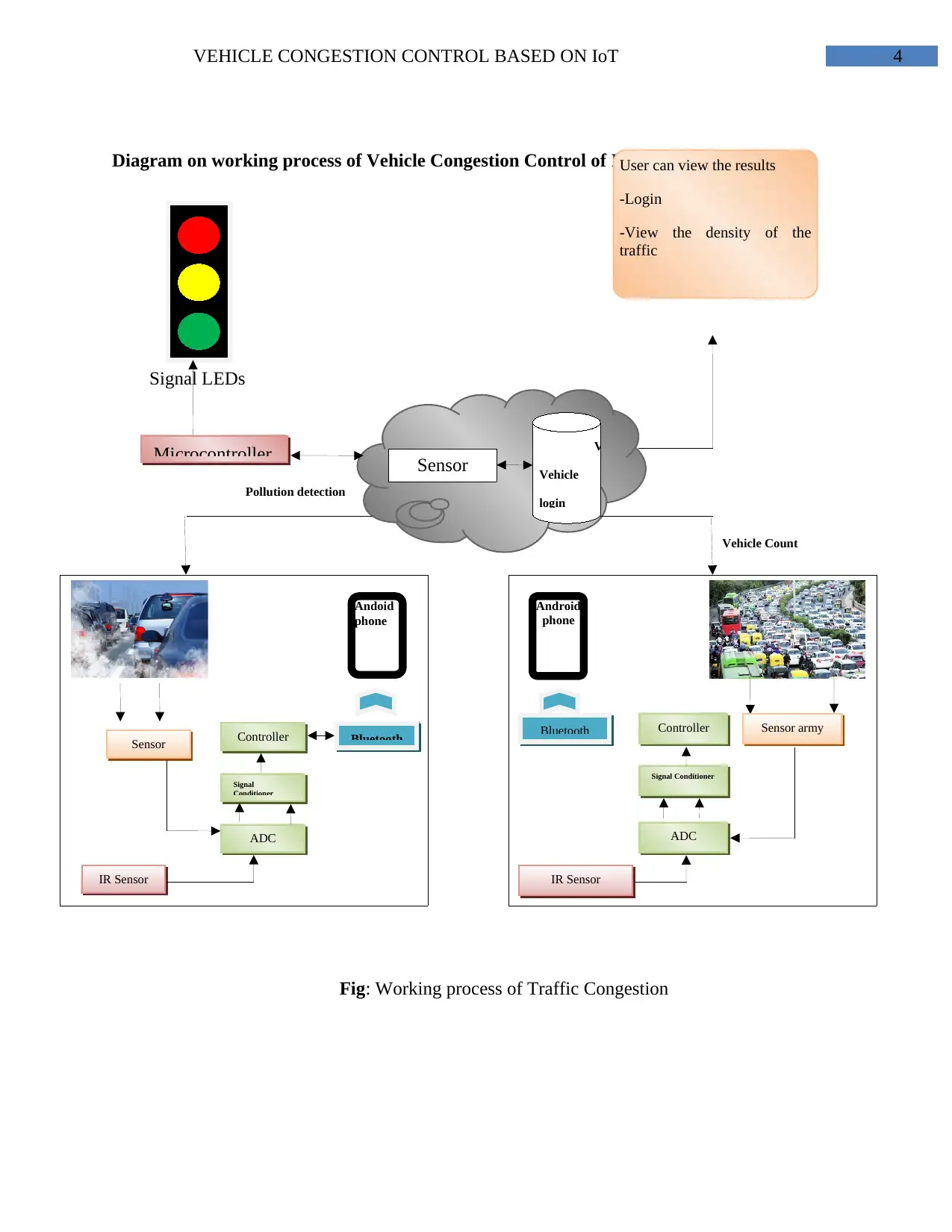
4VEHICLE CONGESTION CONTROL BASED ON IoT
Diagram on working process of Vehicle Congestion Control of IoT
Signal LEDs
Pollution detection
Vehicle Count
Fig: Working process of Traffic Congestion
Sensor
V
Vehicle
login
User can view the results
-Login
-View the density of the
traffic
Microcontroller
Andoid
phone
Sensor
army
Bluetooth
IR Sensor
ADC
Signal
Conditioner
Controller Sensor armyBluetooth
IR Sensor
ADC
Signal Conditioner
Controller
Android
phone
Diagram on working process of Vehicle Congestion Control of IoT
Signal LEDs
Pollution detection
Vehicle Count
Fig: Working process of Traffic Congestion
Sensor
V
Vehicle
login
User can view the results
-Login
-View the density of the
traffic
Microcontroller
Andoid
phone
Sensor
army
Bluetooth
IR Sensor
ADC
Signal
Conditioner
Controller Sensor armyBluetooth
IR Sensor
ADC
Signal Conditioner
Controller
Android
phone
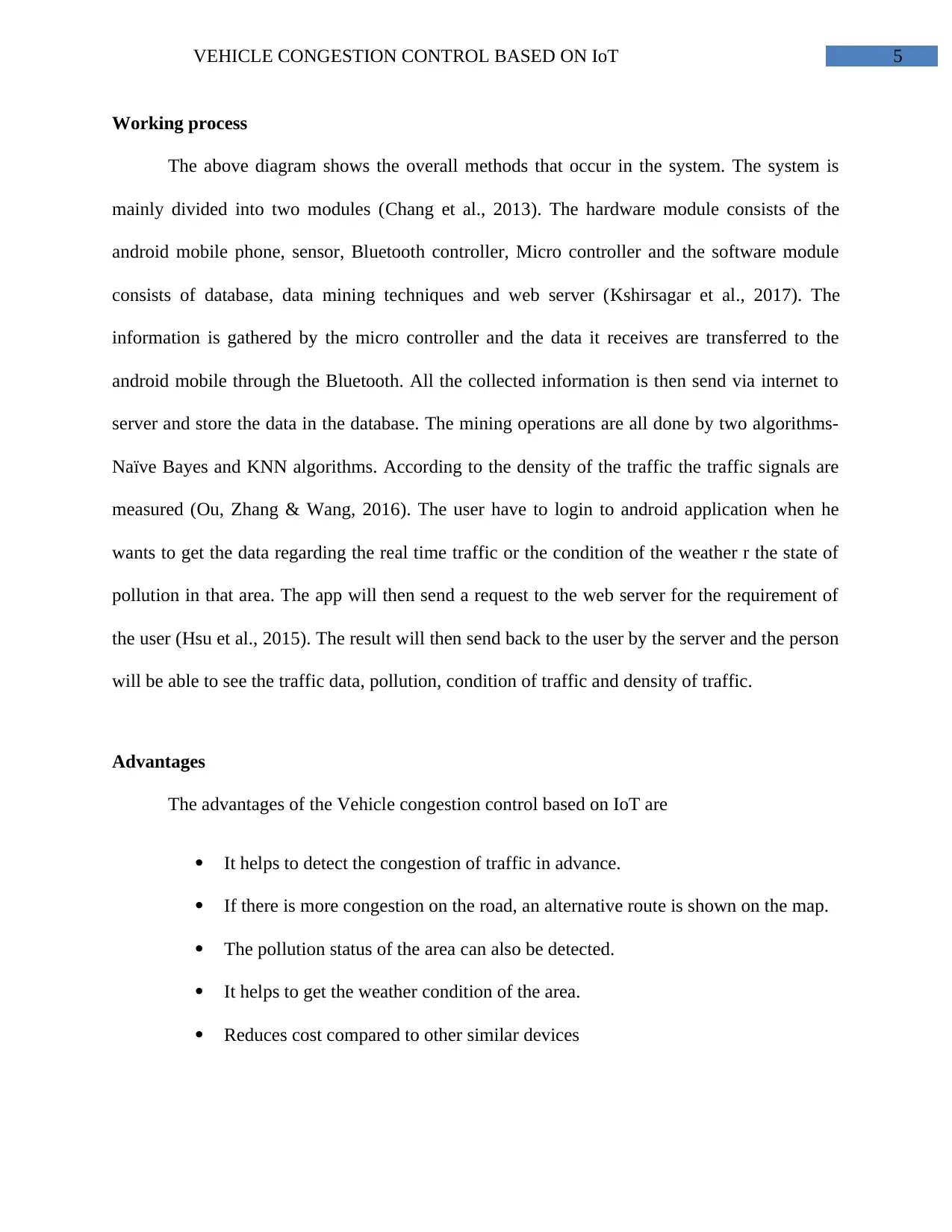
5VEHICLE CONGESTION CONTROL BASED ON IoT
Working process
The above diagram shows the overall methods that occur in the system. The system is
mainly divided into two modules (Chang et al., 2013). The hardware module consists of the
android mobile phone, sensor, Bluetooth controller, Micro controller and the software module
consists of database, data mining techniques and web server (Kshirsagar et al., 2017). The
information is gathered by the micro controller and the data it receives are transferred to the
android mobile through the Bluetooth. All the collected information is then send via internet to
server and store the data in the database. The mining operations are all done by two algorithms-
Naïve Bayes and KNN algorithms. According to the density of the traffic the traffic signals are
measured (Ou, Zhang & Wang, 2016). The user have to login to android application when he
wants to get the data regarding the real time traffic or the condition of the weather r the state of
pollution in that area. The app will then send a request to the web server for the requirement of
the user (Hsu et al., 2015). The result will then send back to the user by the server and the person
will be able to see the traffic data, pollution, condition of traffic and density of traffic.
Advantages
The advantages of the Vehicle congestion control based on IoT are
It helps to detect the congestion of traffic in advance.
If there is more congestion on the road, an alternative route is shown on the map.
The pollution status of the area can also be detected.
It helps to get the weather condition of the area.
Reduces cost compared to other similar devices
Working process
The above diagram shows the overall methods that occur in the system. The system is
mainly divided into two modules (Chang et al., 2013). The hardware module consists of the
android mobile phone, sensor, Bluetooth controller, Micro controller and the software module
consists of database, data mining techniques and web server (Kshirsagar et al., 2017). The
information is gathered by the micro controller and the data it receives are transferred to the
android mobile through the Bluetooth. All the collected information is then send via internet to
server and store the data in the database. The mining operations are all done by two algorithms-
Naïve Bayes and KNN algorithms. According to the density of the traffic the traffic signals are
measured (Ou, Zhang & Wang, 2016). The user have to login to android application when he
wants to get the data regarding the real time traffic or the condition of the weather r the state of
pollution in that area. The app will then send a request to the web server for the requirement of
the user (Hsu et al., 2015). The result will then send back to the user by the server and the person
will be able to see the traffic data, pollution, condition of traffic and density of traffic.
Advantages
The advantages of the Vehicle congestion control based on IoT are
It helps to detect the congestion of traffic in advance.
If there is more congestion on the road, an alternative route is shown on the map.
The pollution status of the area can also be detected.
It helps to get the weather condition of the area.
Reduces cost compared to other similar devices
⊘ This is a preview!⊘
Do you want full access?
Subscribe today to unlock all pages.

Trusted by 1+ million students worldwide
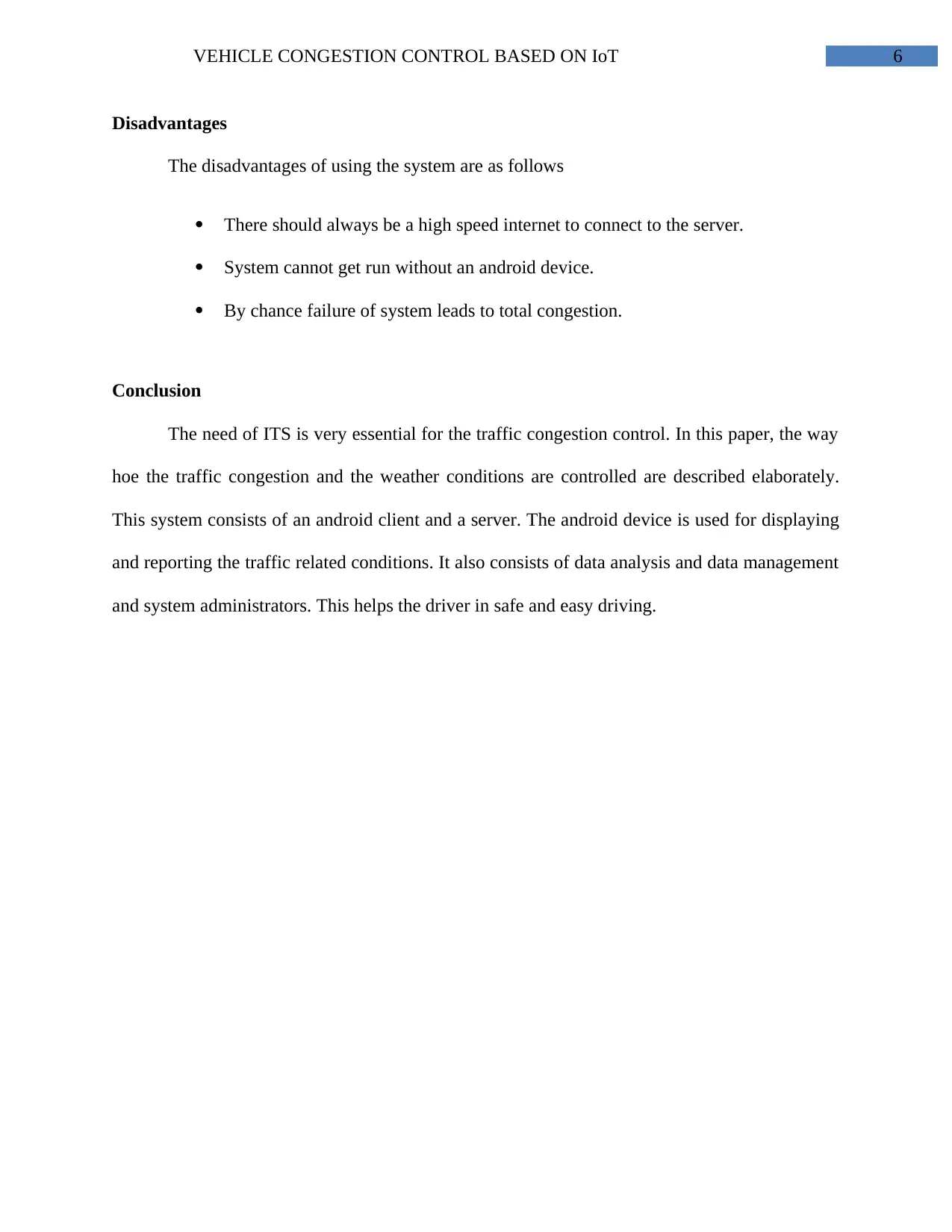
6VEHICLE CONGESTION CONTROL BASED ON IoT
Disadvantages
The disadvantages of using the system are as follows
There should always be a high speed internet to connect to the server.
System cannot get run without an android device.
By chance failure of system leads to total congestion.
Conclusion
The need of ITS is very essential for the traffic congestion control. In this paper, the way
hoe the traffic congestion and the weather conditions are controlled are described elaborately.
This system consists of an android client and a server. The android device is used for displaying
and reporting the traffic related conditions. It also consists of data analysis and data management
and system administrators. This helps the driver in safe and easy driving.
Disadvantages
The disadvantages of using the system are as follows
There should always be a high speed internet to connect to the server.
System cannot get run without an android device.
By chance failure of system leads to total congestion.
Conclusion
The need of ITS is very essential for the traffic congestion control. In this paper, the way
hoe the traffic congestion and the weather conditions are controlled are described elaborately.
This system consists of an android client and a server. The android device is used for displaying
and reporting the traffic related conditions. It also consists of data analysis and data management
and system administrators. This helps the driver in safe and easy driving.
Paraphrase This Document
Need a fresh take? Get an instant paraphrase of this document with our AI Paraphraser
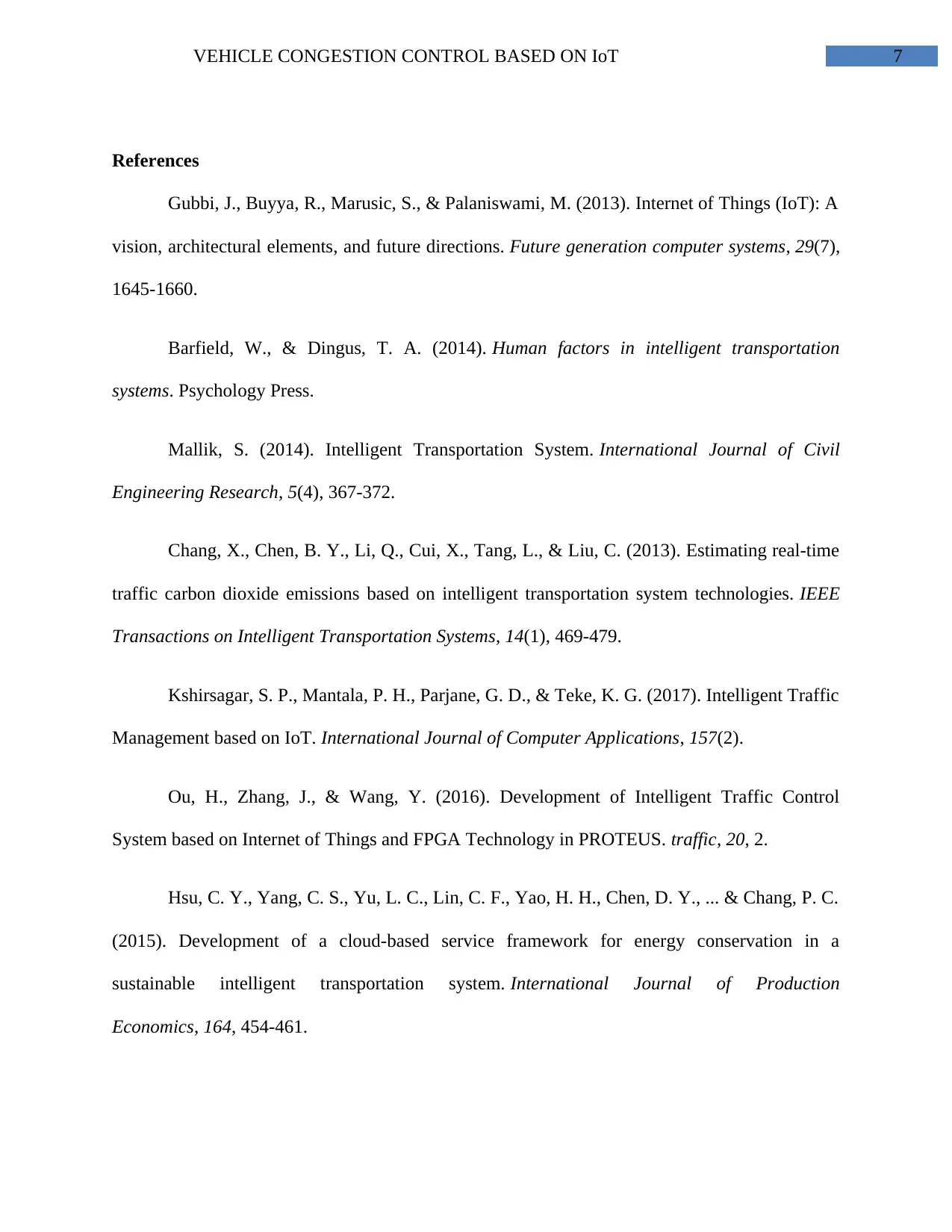
7VEHICLE CONGESTION CONTROL BASED ON IoT
References
Gubbi, J., Buyya, R., Marusic, S., & Palaniswami, M. (2013). Internet of Things (IoT): A
vision, architectural elements, and future directions. Future generation computer systems, 29(7),
1645-1660.
Barfield, W., & Dingus, T. A. (2014). Human factors in intelligent transportation
systems. Psychology Press.
Mallik, S. (2014). Intelligent Transportation System. International Journal of Civil
Engineering Research, 5(4), 367-372.
Chang, X., Chen, B. Y., Li, Q., Cui, X., Tang, L., & Liu, C. (2013). Estimating real-time
traffic carbon dioxide emissions based on intelligent transportation system technologies. IEEE
Transactions on Intelligent Transportation Systems, 14(1), 469-479.
Kshirsagar, S. P., Mantala, P. H., Parjane, G. D., & Teke, K. G. (2017). Intelligent Traffic
Management based on IoT. International Journal of Computer Applications, 157(2).
Ou, H., Zhang, J., & Wang, Y. (2016). Development of Intelligent Traffic Control
System based on Internet of Things and FPGA Technology in PROTEUS. traffic, 20, 2.
Hsu, C. Y., Yang, C. S., Yu, L. C., Lin, C. F., Yao, H. H., Chen, D. Y., ... & Chang, P. C.
(2015). Development of a cloud-based service framework for energy conservation in a
sustainable intelligent transportation system. International Journal of Production
Economics, 164, 454-461.
References
Gubbi, J., Buyya, R., Marusic, S., & Palaniswami, M. (2013). Internet of Things (IoT): A
vision, architectural elements, and future directions. Future generation computer systems, 29(7),
1645-1660.
Barfield, W., & Dingus, T. A. (2014). Human factors in intelligent transportation
systems. Psychology Press.
Mallik, S. (2014). Intelligent Transportation System. International Journal of Civil
Engineering Research, 5(4), 367-372.
Chang, X., Chen, B. Y., Li, Q., Cui, X., Tang, L., & Liu, C. (2013). Estimating real-time
traffic carbon dioxide emissions based on intelligent transportation system technologies. IEEE
Transactions on Intelligent Transportation Systems, 14(1), 469-479.
Kshirsagar, S. P., Mantala, P. H., Parjane, G. D., & Teke, K. G. (2017). Intelligent Traffic
Management based on IoT. International Journal of Computer Applications, 157(2).
Ou, H., Zhang, J., & Wang, Y. (2016). Development of Intelligent Traffic Control
System based on Internet of Things and FPGA Technology in PROTEUS. traffic, 20, 2.
Hsu, C. Y., Yang, C. S., Yu, L. C., Lin, C. F., Yao, H. H., Chen, D. Y., ... & Chang, P. C.
(2015). Development of a cloud-based service framework for energy conservation in a
sustainable intelligent transportation system. International Journal of Production
Economics, 164, 454-461.
1 out of 8
Related Documents
Your All-in-One AI-Powered Toolkit for Academic Success.
+13062052269
info@desklib.com
Available 24*7 on WhatsApp / Email
![[object Object]](/_next/static/media/star-bottom.7253800d.svg)
Unlock your academic potential
Copyright © 2020–2025 A2Z Services. All Rights Reserved. Developed and managed by ZUCOL.



